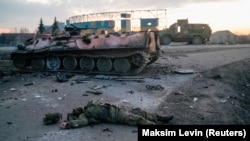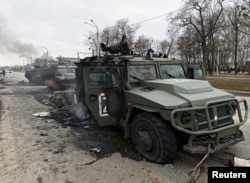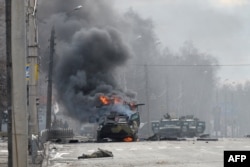On February 22, 2022, Josep Borrell, the European Union’s foreign policy chief, took a phone call from the United States’ top diplomat.
According to Borrell, U.S. Secretary of State Antony Blinken told him that Russia, after months of building up a massive military force on Ukraine’s border, was, in fact, going to invade.
“Tony Blinken phoned me and told me, ‘Well, it is going to happen this weekend’,” Borrell recalled in a speech months later. “And certainly, two days later, at 5 o’clock in the morning, they started bombing Kyiv. We did not believe that this was going to happen.
“We did not believe that the war was coming,” he said.
Everyone thought Russia wouldn’t invade a sovereign country.... That the buildup was a bluff. It was a psychological barrier.”-- Defense analyst Konrad Muzyka
As the drumbeat of war grew louder in the months before February 24, 2022, Western intelligence officers, military analysts, and political scientists struggled to divine Russian President Vladimir Putin’s intentions. They also looked hard at what was known about Russia’s modernized, reformed, and well-financed armed forces -- not to mention the ragtag, underequipped state of Ukraine’s military.
Many believed Russia would not invade. Wrong.
And many believed that if it did, Ukraine’s military would be routed, Kyiv would be captured in a matter of days, and the government would fall. Wrong again.
One year on, as the war rages with no end in sight, analysts are still trying to piece together how most of the Western world got so much so wrong.
“Clearly, I did not make the big call, which would have been to join those who had been convinced for some time that a big war was about to start,” Lawrence Freedman, a professor emeritus of war studies at King’s College London, said in a commentary in late December. “I was becoming increasingly persuaded of its possibility, but it still seemed to be such a self-evidently stupid move that I assumed that Putin had better options.”
In an interview, Freedman said that, in hindsight, both U.S. officials and their British counterparts were correct in their predictions that Putin would order the invasion to go forward.
“The big call that the Americans and British made turned out to be right,” he told RFE/RL.
“Undoubtedly, it was a great intelligence success,” said Konrad Muzyka, a Polish-based defense analyst. “We’re used to talking about intelligence failures when it comes to the U.S.: the failures to predict the invasion of Georgia, Syria, all the stuff during the Cold War, the invasion of Hungary, Czechoslovakia.”
“What the U.S. intelligence community predicted was spot-on,” he said. “They provided everyone with a lot of warning, which was luxurious, because you usually don’t really get that much warning.”
The unwillingness of many Western officials to believe the warnings was psychological, Muzyka said.
“Many people thought, ‘Here it is, the 21st century. The conflict had been going on for nine years, eight years’” in the Donbas in eastern Ukraine, he said. “Everyone thought Russia wouldn’t invade a sovereign country.... That the buildup was a bluff. It was a psychological barrier.”
Quality Versus Quantity
Before the invasion, there were two lines of intelligence coming out, said Philip Davies, a professor of intelligence studies at the Brunel Centre for Intelligence and Security Studies in London: “warning intelligence” and “correlation of forces” intelligence.
“What is in question isn’t the quality of the collection, it’s the quality of the analysis,” Davies said.
“The analysis on warning intelligence was extremely accurate,” he said. “The American warnings, which were the loudest… are accurate to within seven to 10 days, which in the scale of these things is pretty accurate.
“This is about intentions,” Freedman said. “No one was questioning the intelligence of what the Russians had around the borders. The question is whether it would be used. The difficulty there is you’re trying to assess someone’s choices, the decisions that may not have been made yet.”
New And Improved. Or Not.
Russia’s invasion of Georgia in 2008 was lightning fast -- almost all fighting ended after five days -- but the conflict highlighted glaring problems with Russia's armed forces, spurring a sweeping effort to modernize and move away from Soviet legacy equipment and practices.
After smaller-scale successes in Ukraine in 2014 and then later in Syria, Western observers concluded that the reforms had improved Russia’s ability to move quickly, to coordinate movement across disparate units, to communicate better, and to use better, “smart” technology.
In 2020, Russian Defense Minister Sergei Shoigu declared that as much as 70 percent of the armed forces vehicles, weaponry, and equipment has been modernized.
And then came the 2022 Ukraine invasion.
For months ahead of February 24, 2022, U.S. and British intelligence agencies and diplomats publicly detailed what they said were Kremlin plans for the invasion. In November 2021, CIA Director William Burns traveled to Moscow to directly warn Russian officials against invading. But, as Burns later said, he left "more troubled than when I arrived.”
With upwards of 175,000 troops deployed in regions along the Ukrainian border, and naval dominance in the Black Sea, Russia’s forces were expected to steamroll into Ukraine, taking Kyiv in a few days and toppling President Volodymyr Zelenskiy’s government.
Instead, Russia’s efforts to quickly seize Kyiv from the north were thwarted -- in large part by the successful defense of an airfield just north of the capital, which prevented paratroopers from landing. In the south, Russia had more success, capturing the administrative capital of the Kherson region and then, after a weeks-long siege, capturing the Azov Sea port city of Mariupol.
By spring, Russian units had withdrawn from northern districts, retreating across the border and redeploying for a new effort in eastern Ukraine.
“Why Russia did not prevail -- why it was instead stopped in its tracks, routed outside major cities, and put on the defensive -- has become one of the most important questions in both U.S. foreign policy and international security more broadly,” Dara Massicot, an expert on the Russian military at the Rand Corporation, a U.S. think tank, wrote in an article published this month in Foreign Affairs.
“Where people got it wrong it was in their assessments of the Russian Army,” Freedman said. “It was not preordained that the Russians would screw up so badly.”
'Potemkin Village'
“I was surprised with how well the Ukrainians performed and how poorly the Russians executed,” said Clint Reach, a defense researcher at Rand Corporation and a former Russian linguist in the U.S. Navy and Defense departments. “Despite a poor plan on Russia's part, Russia has shown it was not the military we thought it was going into the war. And that expectation of Russia was based on assumptions that modernization and training efforts over a decade would produce results on the battlefield. We have not seen that."
“The Russians have been working very hard at building up what you might call a Potemkin village of military capability,” Davies said.
He pointed to the example of Russia’s newest tank -- the T-14 Armata -- which, despite vaunted technologies and military officials bragging about its capabilities, has yet to be deployed in Ukraine.
“It's easy to look at an adversary on paper, look at it and count [equipment]…. You can take all the satellite photographs you want. You can count up all the tanks and armored fighting vehicles, and the aircraft and what have you, and add up the balance sheet -- who's got more on one side or the other,” he said. “But the willingness to use it, the ability to use it, and the skill in using it: You can't see that in a satellite photograph.”
“Unfortunately, I was on the wrong side as well, a wrong assessment of the Russian armed forces’ ability to conduct their attack on Ukraine,” Muzyka said.
“We know based on the exercises, the investment the Russians had made since 2012, they appeared that they should do much better,” he said. “We thought all branches of the forces would perform much better, especially in the northern parts of the country.”
The same missed prognosis holds true for Ukraine, whose forces, many experts forecast, would not be able to hold out for long against a larger, better-equipped Russian Army. Instead, supplied with some Western weaponry and intelligence, Ukrainian forces thwarted the early Russian attempt to capture Kyiv.
“We did not foresee how effectively Ukraine would resist,” Borrell said in his October speech.
“I overestimated the Russian capabilities,” Muzyka said. “On the other hand, you have to remember the initial confusion and chaos on the Ukrainian side, in the initial days of the war.
“The only thing that stopped the Russians from going into Kyiv was the group of a few hundred volunteers that had been preparing for this invasion for months, and it was their resistance in Bucha and Irpin that stalled Russian advances.”
Later, Ukraine surprised Russia -- and outside observers -- when it staged a lightning counteroffensive in the Kharkiv region in the northeast and pressured Russian forces in the Kherson region, in the south, until they withdrew across the defensive barrier of the Dnieper River -- abandoning the only regional capital they had taken since the February invasion.
“I didn’t think the Ukrainians would fare as well as they did,” Davies said. “I really went into it with this kind of very pessimistic stance that, given all the best toys in the world, the best you can do is give the Russians a bloody nose and make it very expensive for them and make them suffer under sanctions for the next 20 years.”
WATCH: A bus riddled with bullet holes, burning vehicles, and corpses on the street. These were the scenes filmed by Current Time reporters in Kyiv on February 28, 2022.
Experts have also homed in on another perplexing aspect of Russia’s invasion: the inability, or unwillingness, of Russia to use its air force more aggressively. Armed with Western anti-aircraft weaponry, Ukraine has continued to operate its smaller Soviet-built fleet of jets and other warplanes, and to avoid the prospect of having its ground forces battered by Russian jets.
“We assumed the Russians not only had superiority of air power but also knew how to use it efficiently,” Freedman said. “But they did not.”
Spy Versus Spy
Western governments and analysts were not alone in their predictions about how the invasion of Ukraine would unfold. Russia’s intelligence also was flawed, according to multiple Russian press accounts and public statements by Western officials.
One widely cited example involved a department of Russia’s main domestic security agency -- the Federal Security Service -- which was responsible for analysis of Ukraine’s internal politics. Unconfirmed reports in the months after the invasion said the department’s director and his deputy had been investigated and put under house arrest, purportedly for providing the Kremlin with wildly optimistic assessments that Zelenskiy’s government would collapse quickly.
And then there’s the question of how much Ukraine itself knew about Russia’s intentions, Davies said.
“There's a dog that's not barking in the night in all these discussions,” he said.
“I have a sneaking suspicion…that the Ukrainians probably had quite good intelligence on the Russians,” Davies said, “and had quite a long time to invest in having good intelligence on the Russians. And [they] seem to have been better prepared for the poor state of Russian preparation than everyone else.
“How solid, how detailed the intelligence was that the Ukrainians had on the Russians, and what kind of intelligence -- especially their human operations -- had on the Russians,” he said. “I think that will, when all the papers come out years from now, prove to be much more significant in how things played out then than we're giving them credit for right now.”




